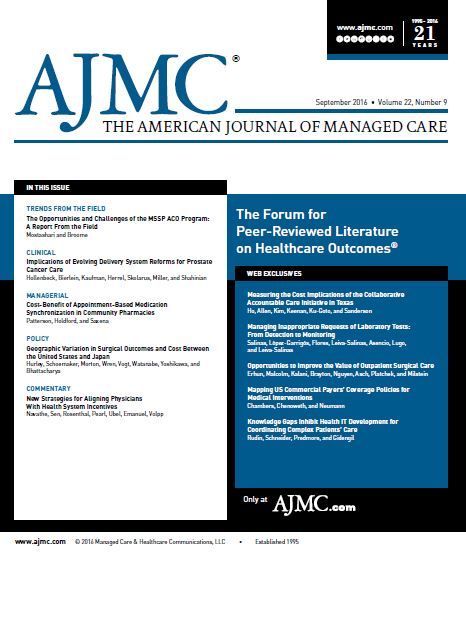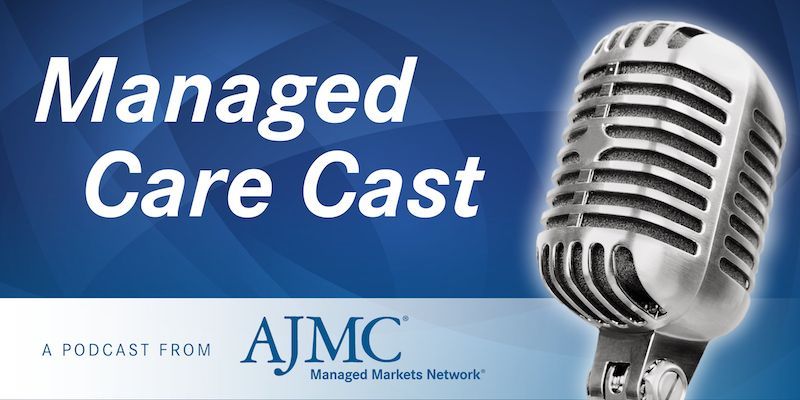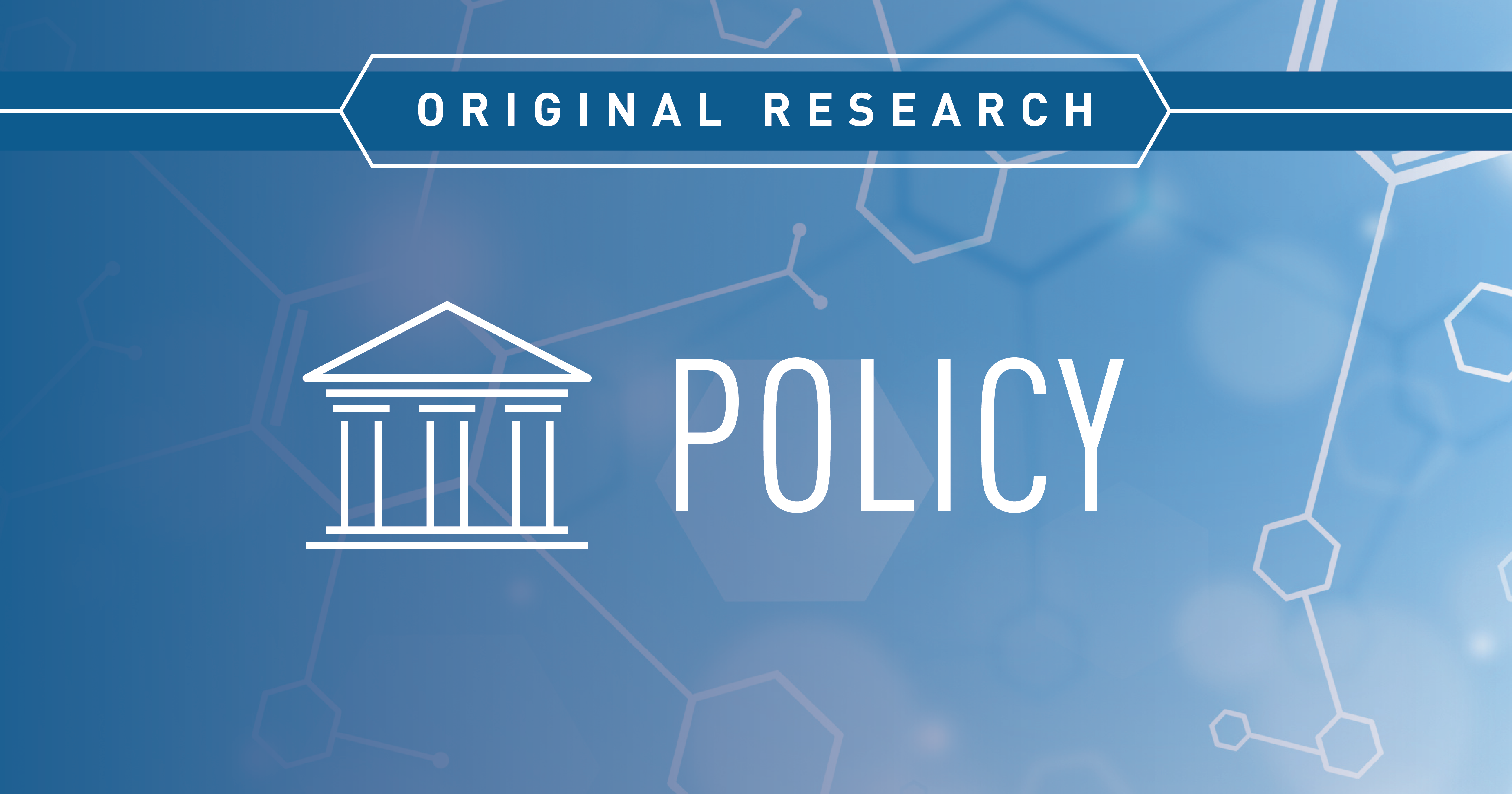Publication
Article
The American Journal of Managed Care
Cost-Benefit of Appointment-Based Medication Synchronization in Community Pharmacies
Author(s):
This study conducted a cost-benefit analysis of appointment-based medication synchronization for improving adherence in patients on chronic medications for hypertension, hyperlipidemia, and diabetes.
ABSTRACT
Objectives: To evaluate the cost-benefit of appointment-based medication synchronization (ABMS) offered in community pharmacies for patients taking chronic medications to prevent negative outcomes associated with hyperlipidemia, hypertension, and diabetes.
Study Design: Decision-tree analysis based on published literature and publicly available data.
Methods: Program benefits were based on linking published findings of improvements in medication adherence due to the implementation of an ABMS program to a claims-based study of disease-related medical costs associated with different levels of adherence. The direct cost of the program—increased medication utilization as a result of improved adherence—was calculated from publicly available prescription pricing data. Benefit-cost ratios were assessed from a payer perspective over a 1-year time frame.
Results: Additional medication expenditures due to improved adherence associated with ABMS enrollment were offset by lower disease-specific medical costs. Medical savings per additional dollar spent on medications ranged from approximately $1 to $37 depending on the medication and medication class considered. ABMS was most cost-beneficial for metformin and statins. Sensitivity analyses showed that cost-benefit was significantly impacted by medication costs and any service fees associated with ABMS.
Conclusions: ABMS programs have been shown to increase medication adherence in patients taking chronic medications. These programs were shown to have a significant cost-benefit for healthcare payers by reducing medical utilization and costs. Payers should consider supporting the provision of these programs in community pharmacies.
Am J Manag Care. 2016;22(9):587-593
Take-Away Points
Appointment-based medication synchronization (ABMS) programs in community pharmacies have been shown to increase medication adherence in patients taking chronic medications.
- Medication expenditures due to improved adherence associated with ABMS enrollment were offset by lower disease-specific medical costs.
- Economic analyses suggest that ABMS programs offer a significant cost-benefit to payers.
- Payers should consider supporting the provision of ABMS programs in community pharmacies.
Medication nonadherence is a major barrier to the provision of effective pharmacotherapy in patients with chronic conditions, and it is also associated with negative health outcomes and increased risks of hospitalization and mortality in patients with a variety of disease states, including cardiovascular conditions and diabetes.1-3 It is estimated that 33% to 69% of medicine-related hospitalizations are caused by poor adherence.4 Additionally, medication nonadherence accounts for projected annual US healthcare expenditures of $100 to $300 billion4; improving adherence, on the other hand, has been projected to result in annual per-person savings ranging from $1000 to over $7000 depending on the disease state.5,6 These savings reflect the association between poor adherence and increased nursing home admissions, physician visits, and hospitalizations and are robust even after controlling for healthy adherer behaviors.1,2,7-9
Although studies vary in their estimated rates of nonadherence for long-term medications, most studies report adherence at approximately 50%.10-12 Rates of adherence tend to decline over time and are lower in patients who are prescribed multiple chronic medications.13,14 Adherence appears to be similarly low among patients with hypertension, type 2 diabetes, or hyperlipidemia.10,15
Causes of medication nonadherence are multifactorial and often involve interconnecting patient, treatment plan, and healthcare system factors.4,16 Efforts to improve adherence often fail to achieve long-term desired results because they are too narrow in scope. Interventions, such as drug reminder packaging, mobile text messaging, and written and oral education, have inconsistent impact on both measures of adherence and clinical outcomes.17-19 Even when the scope of interventions is more ambitious, as with comprehensive medication therapy management, programs are not sustainable because they are often labor-intensive and costly.20
Pharmacists are well-positioned to impact patient adherence, particularly in community pharmacy settings.21 Regular pharmacist—patient communication and monitoring has consistently been linked to improved adherence.22,23 Still, current community pharmacy efforts at counseling, monitoring, and education show variable rates of success.24,25
Appointment-based medication synchronization (ABMS)—a system that offers individualized solutions to patients’ medication-related barriers—has been suggested as an effective and sustainable way of improving medication adherence in community pharmacies.26,27 In ABMS, pharmacists work with patients to synchronize their chronic medications to be filled on a single day each month. Prior to this date every month, pharmacists review patients’ medications, address patient concerns, and discuss any changes to the medication regimen. This system is designed to simplify the complexity of patients’ medication regimens and provide opportunities for consistent pharmacist—patient communications, which can help to clarify, modify, and enhance patient therapy. Communications with physicians are also enhanced through a formal process of physician contact regarding patient enrollment in the program and periodic calls to address medication therapy issues.
ABMS has demonstrated significant impact on patient adherence and persistence for chronic medications.27,28 A study in rural pharmacies in the midwestern United States showed that patients enrolled in an ABMS program who newly started a chronic medication had 3.4 to 6.1 times greater odds of adherence over a 1-year period than matched comparisons.27 Another study, of Ohio pharmacies with patients who had been taking chronic medicines for 6 months or more, indicated 2.3 to 3.6 times greater odds of adherence over a 1-year period with ABMS.28 These studies indicate that ABMS can be effective in improving medication adherence and, thereby, possibly improve health outcomes; however, there have been no analyses of the economic consequences of these programs.
The objective of this study was to model the economic impact of ABMS in community pharmacies for patients taking medications to prevent negative outcomes associated with diabetes, hypertension, and hyperlipidemia. The analysis was conducted from the perspective of a healthcare payer who wants to quantify the value to chronic disease populations of individuals enrolling in ABMS programs offered by community pharmacies.
METHODS
The patients studied in the ABMS program consisted of adults who had been taking chronic medicines for 6 months or more and received at least 2 refills for at least 1 of 6 types of chronic disease medication categories. The medication classes studied were angiotensin-converting enzyme (ACE) inhibitors/angiotensin receptor blockers (ARBs), beta-blockers (BBs), dihydropyridine calcium channel blockers (DCCBs), thiazide diuretics, metformin, and statins. Patients who opted into the ABMS program were matched with control patients who received standard pharmacy dispensing services. Matching was done according to patient history of prior adherence behavior, medication class, age, gender, and geographic region.
A decision-tree analysis (eAppendix, available at www.ajmc.com) was constructed to model the cost-benefit of ABMS programs when compared with standard community pharmacy dispensing practices. The results of separate cost-benefit analyses for each medication class were presented with benefit-cost ratios calculated as follows:
Total Disease-Specific Direct Medical Costs Saved Due to Improved Medication Adherence Associated With ABMS (Diabetes, Hypertension, Hyperlipidemia) /
Total Medication Costs Added Due to Improved Medication Adherence Associated With ABMS
The model estimated, in US dollars, the benefit of the program on reduced disease-specific health expenditures over a 1-year period, relative to additional medication costs. Program benefits came from projecting how improvements in medication adherence due to the program would reduce medical costs for the treatment of the disease state associated with each medication class. This was done by matching adherence levels to chronic medications reported in an ABMS study,28 with research linking the same adherence with disease-related medical costs (Table 1).5 Program costs were estimated based on the average cost per prescription refill and the number of additional fills due to improved adherence.
Adherence data for the base-case model came from the Ohio ABMS study of individuals on the chronic medications for at least 6 months.28 The proportion of days covered (PDC)—a ratio of the number of days covered by prescription fills divided by the total number of days in a study period—was used to measure adherence. PDC scores range from 0 to 1, with larger proportions indicating greater adherence. The PDC scores for patients from the study28 were stratified into 5 categories (PDC scores of 1%-20%, 21%-40%, 41%-60%, 61%-80%, and 81%-100%) to match utilization data in the study linking medication adherence with disease-related medical costs.5
To model the relationship between medication adherence and disease-specific medical costs, indications needed to be assigned to the medication classes. The indication for ACE inhibitors/ARBs, BBs, DCCBs, and thiazide diuretics was assumed to be hypertension.29 Metformin and statins were assumed to be treating diabetes and hyperlipidemia, respectively. This allowed each of the 5 levels of adherence (1%-20%, 21%-40%, 41%-60%, 61%-80%, 81%-100%) to be matched with data from research linking these medication adherence levels with disease-related healthcare costs.5
Additional costs associated with ABMS in the base case came from the increased medication costs that resulted from a higher number of annual medication refills. In the calculation of medication cost per fill, the price of the medication from each class with the highest total prescriptions in 2012 was assumed to be representative of the entire class.30 These representative drugs were lisinopril (ACE inhibitors/ARBs), simvastatin (statins), metoprolol (BBs), amlodipine (DCCBs), hydrochlorothiazide (thiazide diuretics), and metformin (diabetic medications). Cost per fill was calculated at an assumed cost of average wholesale price (AWP) minus 70% to reflect generic drug pricing.31-34
Sensitivity analyses were conducted on key variables in the model. These variables included the relative effectiveness of ABMS compared with usual care on medication adherence, cost of chronic medications, medical costs, patient cost sharing, and addition of a service fee for the program.
RESULTS
Adherence data for comparing ABMS with controls are presented in Table 2. Significantly more patients in the ABMS program had PDC scores of 81% to 100%, whereas patients in the comparison group had more patients in categories with lower PDC scores.
Table 3 shows disease-related medical costs for levels of medication adherence adjusted to 2015 costs, according to the medical inflation index.35 With the exception of drug costs, which increased with greater adherence, direct medical costs were much lower, on average, for patients with higher PDC scores.
Benefit-cost ratios for 6 medication classes were reported (Table 4). In base-case analyses of the cost-benefit, ABMS enrollment was associated with slight increases in medication expenditures due to improved adherence, but lower disease-specific medical costs. Medical savings per additional dollar spent on medications ranged from $1.25 to almost $37 depending on the medication class. ABMS yielded the greatest benefit relative to costs for metformin and statins and lower benefits relative to costs for thiazide diuretics and ACE inhibitors/ARBs.
One-way sensitivity analyses varied the medication costs from as low as Veterans’ Health Administration (VA) costs, obtained from the National Acquisition Center website, to as high as the AWP. Additional medication costs included in the sensitivity analyses included AWP minus 50% (AWP — 50%) and AWP minus 30% (AWP – 30%) (Table 4).36 In additional 1-way sensitivity analyses, disease-specific medical costs and the PDC distribution of ABMS patients were each increased and decreased by 20%. (Table 5).
The impact of adding a service fee to ABMS programs was also examined in sensitivity analyses. ABMS is currently offered free of charge by most pharmacies, so the effect of annual per-patient fees of $100, $150, and $200 for program enrollment was explored in sensitivity analyses. In addition, co-payments of $5 and $10 per fill were included in sensitivity analyses to reflect average cost-sharing arrangements with patients.37 Discounting was not performed because both costs and outcomes occurred within a 1-year period.
In sensitivity analyses, the benefit-cost ratio of ABMS was most sensitive to drug prices (Table 5). As drug prices were lowered to VA pricing, estimated savings per additional dollar spent on medications ranged from $40 to $301. Favorable cost-benefit findings were robust for metformin, statins, and BBs. Cost-benefit was no longer favorable for thiazides at a drug price of AWP — 50%, ACE inhibitors/ARBs at AWP – 30%, and DCCBs at AWP. With the introduction of patient cost sharing through a $10 co-pay, benefit-cost ratios increased from 3.8 to 1 up to 59 to 1, depending on the drug class and assuming that co-pays did not reduce medication adherence. Cost-benefit was robust to changes in medical costs and ABMS effectiveness; however, with the introduction of payer reimbursements for ABMS, benefit-cost ratios remained favorable only for metformin and statins.
DISCUSSION
This study quantifies the cost-benefit of an ABMS model to improve adherence among patients prescribed chronic medications. Previously studied interventions to improve nonadherence often lack reliable effectiveness or contribute to higher overall costs to a payer or provider. ABMS has a demonstrated impact on improving adherence and persistence to chronic medications,27,28 which can increase annual medication costs to a payer on account of increased annual medication refills. This study calculated the overall disease-related healthcare savings attributed to improved adherence due to ABMS and analyzed the cost-benefit of ABMS compared with standard pharmacy dispensing from a payer perspective.
Few studies have used cost-benefit analyses to model the costs and outcomes of community pharmacy-based adherence interventions, and even fewer have taken a payer perspective.38,39 This study found that, due to improved adherence with ABMS, the disease-related medical savings per additional dollar spent on medications ranged from $1.25 to nearly $37 for 6 classes of chronic medications. These results suggest that payer partnerships with pharmacies offering ABMS are cost-beneficial and provide a positive return on investment.
ABMS works within the existing framework of medication dispensing in a community pharmacy setting to emphasize proactive medication management and consistent patient—provider communication. Because it can be incorporated into a pharmacy workflow, the nondrug cost of ABMS programs is minimal to the pharmacy and is provided free of charge to patients and payers. The combined low cost and high effectiveness of ABMS promotes more favorable cost-benefit ratios than expensive, but effective, educational and management interventions40 and low-cost, but less effective, electronic and reminder interventions.41
The addition of pharmacist compensation to ABMS programs was not justified in this economic model. Annual per-patient fees were not made up by medical savings of negative health consequences, although the results might change for populations who are at greater risk of chronic illnesses or if the analysis looked at a time period longer than 1 year. Furthermore, this analysis was limited to separate analyses for each medication class, when patients with diabetes and hypertension take, on average, 4.1 and 1.7 disease-related prescriptions, respectively.42,43
The widespread implementation of ABMS faces a number of barriers. Pharmacy benefit managers (PBMs) may not be incentivized to support ABMS under some business models. Additionally, ABMS would not benefit PBMs whose performance is measured solely on medication cost, as medication costs increase with improved adherence. Here, the disease-specific medical savings would show up on the income statements of other payers. PBM disincentives might also exist for ABMS programs offered by pharmacies that are out-of-network. ABMS programs might hinder PBM efforts to shift dispensing to mail order services or influence terms of contract for rebates.
Limitations
This research included several limitations. The adherence data was collected from the implementation of ABMS in a small pharmacy chain offering services within a limited geography in Ohio. The impact of ABMS on adherence may not be duplicated for other populations in other settings, although ABMS programs offered by other pharmacies in different geographic locations have shown similar effectiveness.26,27
This study used data that reported associations between ABMS programs and adherence. The participants in the ABMS program opted into the program, which may have made them more likely or motivated to adhere to their medications. Matching ABMS patients to control patients based on prior adherence behavior and demographics aimed to minimize this potential bias. The analysis also did not control for other potential influences on medication adherence, including socioeconomic and insurance status, regimen complexity, and patient health status. Although increasing and decreasing the effectiveness of ABMS by 20% in sensitivity analyses did not substantially change the benefit-cost ratios, the impact of unmeasured confounders and self-selection bias on the association between ABMS programs and adherence is not known.
Finally, this study used data that reported associations between medication adherence and disease-related costs based on the findings of an observational study, and the design of that study has important limitations.5 In their study of the association between medication adherence and healthcare costs, Sokol et al adjusted for demographic and health status variables, but the impact of prior adherence behavior and the healthy adherer effect on their findings is not known. These potential confounders may have biased the results of their observational study toward overestimating the association between improved adherence and lower healthcare costs. However, compared to a study by Roebuck et al,6 which employed more rigorous linear fixed-effects modeling to account for the endogeneity of adherence, the Sokol et al study reports smaller decreases in healthcare costs associated with improved adherence. Beyond providing a more conservative estimate of the association between adherence and medical costs compared with that reported by Roebuck et al, the use of data from the study by Sokol et al in this model provided the opportunity to consider in the cost-benefit model the prescription and medical costs associated with 5, rather than 2, adherence categories.
Additionally, disease-related costs by adherence level were reported over a 1-year time frame. The conditions studied—diabetes, hypertension, and hyperlipidemia—are chronic in nature and are linked to long-term sequelae, including myocardial infarction, stroke, and kidney disease. The limited 1-year time frame utilized in this study may have underestimated the impact of ABMS on long-term adverse health events associated with nonadherence in chronic conditions.
Future Research
This research reports the cost-benefit of a synchronization and appointment-based program for 6 classes of chronic medications. The adherence data for patients with ABMS-based care and usual dispensing practices were linked to previously published, claims-based data reporting the disease-specific medical costs associated with 5 levels of adherence. The direct effect of synchronization, as it relates to patient outcomes and costs, has not been reported. Future research is needed to explore the impact of ABMS on adherence, costs, and outcomes in the same population.
The cost-benefit of maintaining an ABMS program from a pharmacy perspective should also be explored. Synchronization may improve control of medication inventory and efficient personnel scheduling. Improved adherence may also result in increased refill revenue. The impact of ABMS on front-end sales is unknown. ABMS may improve patient loyalty, but it may also reduce up-front sales due to fewer monthly pharmacy visits.
Additional research could focus on expanding ABMS programs to include other chronic disease states, including chronic obstructive pulmonary disease44 and asthma,45 for which other adherence interventions have shown cost-beneficial results. Previously documented interventions have had limited impact on adherence to medications for depression,46 which has been associated with significant increases in medical service utilization47; however, improved adherence may not reduce utilization.48 The cost-benefit of ABMS for depression is not known.
A recent clinical and economic analysis of the use of liraglutide in the treatment of type 2 diabetes concluded that adherent and persistent patients recorded higher total healthcare costs driven by higher pharmacy costs.49 This current study focused on the impact of ABMS on adherence to predominately generic oral medication classes. In these cases, an increase in medication usage confers minimal additional cost; expanding the use of injectable and biologic medications for chronic conditions may impact the benefit-cost ratios by substantially increasing the costs associated with improved adherence. Future research may focus on the cost-benefit of ABMS with more expensive drug classes.
CONCLUSIONS
To our knowledge, this is the first study to evaluate the cost-benefit of ABMS in community pharmacies. The results indicated that ABMS offers payers a positive return on investment. Although further research is needed to evaluate the long-term costs and outcomes of ABMS, payer partnerships with pharmacies offering ABMS may improve patient outcomes in a cost-beneficial manner.
Author Affiliations: Department of Pharmacotherapy and Outcomes Sciences, Virginia Commonwealth University School of Pharmacy (JAP, DAH, KS), Richmond, VA.
Source of Funding: None.
Author Disclosures: The authors report no relationship or financial interest with any entity that would pose a conflict of interest with the subject matter of this article.
Authorship Information: Concept and design (DAH, JAP); acquisition of data (DAH, KS); analysis and interpretation of data (JAP, KS); drafting of the manuscript (JAP); critical revision of the manuscript for important intellectual content (DAH, KS); statistical analysis (JAP); provision of patients or study materials (DAH); and supervision (DAH).
Address Correspondence to: David A. Holdford, BSPharm, MS, PhD, Virginia Commonwealth University School of Pharmacy, Department of Pharmacotherapy and Outcomes Sciences, McGuire Hall, Room 213, PO Box 980533, 1112 East Clay St, Richmond, VA 23298-0533. E-mail: daholdfo@vcu.edu.
REFERENCES
1. Ho PM, Magid DJ, Shetterly SM, et al. Medication nonadherence is associated with a broad range of adverse outcomes in patients with coronary artery disease. Am Heart J. 2008;155(4):772-779. doi: 10.1016/j.ahj.2007.12.011.
2. Ho PM, Bryson CL, Rumsfeld JS. Medication adherence: its importance in cardiovascular outcomes. Circulation. 2009;119(23):3028-3035. doi: 10.1161/CIRCULATIONAHA.108.768986.
3. DiMatteo MR, Giordani PJ, Lepper HS, Croghan TW. Patient adherence and medical treatment outcomes: a meta-analysis. Med Care. 2002;40(9):794-811. doi: 10.1097/01.MLR.0000024612.61915.2D.
4. Osterberg L, Blaschke T. Adherence to medication. N Engl J Med. 2005;353(5):487-497. doi: 10.1056/NEJMra050100.
5. Sokol MC, McGuigan KA, Verbrugge RR, Epstein RS. Impact of medication adherence on hospitalization risk and healthcare cost. Med Care. 2005;43(6):521-530. doi: 00005650-200506000-00002.
6. Roebuck MC, Liberman JN, Gemmill-Toyama M, Brennan TA. Medication adherence leads to lower health care use and costs despite increased drug spending. Health Aff (Millwood). 2011;30(1):91-99. doi: 10.1377/hlthaff.2009.1087.
7. Dragomir A, Côté R, Roy L, et al. Impact of adherence to antihypertensive agents on clinical outcomes and hospitalization costs. Med Care. 2010;48(5):418-425. doi: 10.1097/MLR.0b013e3181d567bd.
8. De Vera MA, Bhole V, Burns LC, Lacaille D. Impact of statin adherence on cardiovascular disease and mortality outcomes: a systematic review. Br J Clin Pharmacol. 2014;78(4):684-698.
9. Stuart BC, Dai M, Xu J, E Loh FH, S Dougherty J. Does good medication adherence really save payers money? Med Care. 2015;53(6):517-523. doi: 10.1097/MLR.0000000000000360.
10. Yeaw J, Benner JS, Walt JG, Sian S, Smith DB. Comparing adherence and persistence across 6 chronic medication classes. J Manag Care Pharm. 2009;15(9):728-740. doi: 10.18553/jmcp.2009.15.9.728.
11. Jackevicius CA, Mamdani M, Tu JV. Adherence with statin therapy in elderly patients with and without acute coronary syndromes. JAMA. 2002;288(4):462-467.
12. Benner JS, Glynn RJ, Mogun H, Neumann PJ, Weinstein MC, Avorn J. Long-term persistence in use of statin therapy in elderly patients. JAMA. 2002;288(4):455-461.
13. Benner JS, Chapman RH, Petrilla AA, Tang SS, Rosenberg N, Schwartz JS. Association between prescription burden and medication adherence in patients initiating antihypertensive and lipid-lowering therapy. Am J Health Syst Pharm. 2009;66(16):1471-1477. doi: 10.2146/ajhp080238.
14. An J, Nichol MB. Multiple medication adherence and its effect on clinical outcomes among patients with comorbid type 2 diabetes and hypertension. Med Care. 2013;51(10):879-887. doi: 10.1097/MLR.0b013e31829fa8ed.
15. Cramer JA, Benedict A, Muszbek N, Keskinaslan A, Khan ZM. The significance of compliance and persistence in the treatment of diabetes, hypertension and dyslipidaemia: a review. Int J Clin Pract. 2008;62(1):76-87. doi: 10.1111/j.1742-1241.2007.01630.x.
16. Krueger KP, Berger BA, Felkey B. Medication adherence and persistence: a comprehensive review. Adv Ther. 2005;22(4):313-356.
17. Krueger KP, Felkey BG, Berger BA. Improving adherence and persistence: a review and assessment of interventions and description of steps toward a national adherence initiative. J Am Pharm Assoc (2003). 2003;43(6):668-678; quiz 678-679.
18. Nieuwlaat R, Wilczynski N, Navarro T, et al. Interventions for enhancing medication adherence. Cochrane Database Syst Rev. 2014;(11):CD000011. doi: 10.1002/14651858.CD000011.pub4.
19. Sapkota S, Brien JA, Greenfield J, Aslani P. A systematic review of interventions addressing adherence to anti-diabetic medications in patients with type 2 diabetes—impact on adherence. PLoS One. 2015;10(2):e0118296. doi: 10.1371/journal.pone.0118296.
20. McDonald HP, Garg AX, Haynes RB. Interventions to enhance patient adherence to medication prescriptions: scientific review. JAMA. 2002;288(22):2868-2879.
21. Cutrona SL, Choudhry NK, Fischer MA, et al. Modes of delivery for interventions to improve cardiovascular medication adherence. Am J Manag Care. 2010;16(12):929-942.
22. Green BB, Cook AJ, Ralston JD, et al. Effectiveness of home blood pressure monitoring, web communication, and pharmacist care on hypertension control: a randomized controlled trial. JAMA. 2008;299(24):2857-2867. doi: 10.1001/jama.299.24.2857.
23. Shore S, Ho PM, Lambert-Kerzner A, et al. Site-level variation in and practices associated with dabigatran adherence. JAMA. 2015;313(14):1443-1450. doi: 10.1001/jama.2015.2761.
24. Van Wijk BL, Klungel OH, Heerdink ER, de Boer A. Effectiveness of interventions by community pharmacists to improve patient adherence to chronic medication: a systematic review. Ann Pharmacother. 2005;39(2):319-328. doi: 10.1345/aph.1E027.
25. Viswanathan M, Kahwati LC, Golin CE, et al. Medication therapy management interventions in outpatient settings: a systematic review and meta-analysis. JAMA Intern Med. 2015;175(1):76-87. doi: 10.1001/jamainternmed.2014.5841.
26. Pharmacy’s appointment based model: a prescription synchronization program that improves adherence. APhA Foundation website. http://www.aphafoundation.org/sites/default/files/ckeditor/files/ABMWhitePaper-FINAL-20130923(3).pdf. Published 2013. Accessed August 2016.
27. Holdford DA, Inocencio TJ. Adherence and persistence associated with an appointment-based medication synchronization program. J Am Pharm Assoc (2003). 2013;53(6):576-583. doi: 10.1331/JAPhA.2013.13082.
28. Holdford D Saxena K. Impact of appointment-based medication synchronization on existing users of chronic medications. J Manag Care Spec Pharm. 2015;21(8):662-669.
29. Straand J, Rokstad KS. Elderly patients in general practice: diagnoses, drugs and inappropriate prescriptions. a report from the More & Romsdal Prescription Study. Fam Pract. 1999;16(4):380-388.
30. Bartholow M. Top 200 drugs of 2012. Pharmacy Times website. http://www.pharmacytimes.com/publications/issue/2013/july2013/top-200-drugs-of-2012. Published July 17, 2013. Accessed April 13, 2015.
31. Lexi-Drugs. Lexicomp Online website. http://www.online.lexi.com. Accessed April 15, 2015.
32. Anderson BN, Cosway R. Effective contracting with pharmacy benefit managers: protecting a plan sponsor’s resources. Health Watch. 2010:22-27. http://us.milliman.com/uploadedFiles/insight/health-published/effective-contracting-with-pharmacy.pdf. Accessed April 13, 2015.
33. Calabrese D. Comparing pharmacy benefit managers: moving well beyond the simple spreadsheet analysis. Am Health Drug Benefits. 2008;1(5):9-19.
34. Medicaid drug price comparisons: average manufacturer price to published prices. Department of Health and Human Services Office of the Inspector General website. https://oig.hhs.gov/oei/reports/oei-05-05-00240.pdf. Published June 2005. Accessed April 13, 2015.
35. Consumer Price Index - all urban consumers [medical care]. Bureau of Labor Statistics website. http://data.bls.gov/timeseries/CUUR0000SAM?output_view=pct_12mths. Accessed April 13, 2015.
36. Pharmaceutical catalog search. US Department of Veterans Affairs, National Acquisition Center (CCST) website. http://www.va.gov/nac/index.cfm?template=Search_Pharmaceutical_Catalog. Accessed April 13, 2015.
37. 2014 Employer Health Benefits Survey. Kaiser Family Foundation website. http://kff.org/health-costs/report/2014-employer-health-benefits-survey/. Published September 10, 2014. Accessed April 30, 2015.
38. Touchette DR, Doloresco F, Suda KJ, et al. Economic evaluations of clinical pharmacy services: 2006-2010. Pharmacotherapy. 2014;34(8):771-793. doi: 10.1002/phar.1414.
39. Perez A, Doloresco F, Hoffman JM, et al; American College of Clinical Pharmacy. ACCP: economic evaluations of clinical pharmacy services: 2001-2005. Pharmacotherapy. 2009;29(1):128. doi: 10.1592/phco.29.1.128.
40. Monson R, Bond CA, Schuna A. Role of the clinical pharmacist in improving drug therapy. clinical pharmacists in outpatient therapy. Arch Intern Med. 1981;141(11):1441-1444.
41. Checchi KD, Huybrechts KF, Avorn J, Kesselheim AS. Electronic medication packaging devices and medication adherence: a systematic review. JAMA. 2014;312(12):1237-1247. doi: 10.1001/jama.2014.10059.
42. Grant RW, Devita NG, Singer DE, Meigs JB. Polypharmacy and medication adherence in patients with type 2 diabetes. Diabetes Care. 2003;26(5):1408-1412.
43. Siegel D, Lopez J, Meier J. Antihypertensive medication adherence in the Department of Veterans Affairs. Am J Med. 2007;120(1):26-32. doi: 10.1016/j.amjmed.2006.06.028.
44. van Boven JF, Tommelein E, Boussery K, et al. Improving inhaler adherence in patients with chronic obstructive pulmonary disease: a cost-effectiveness analysis. Respir Res. 2014;15:66. doi: 10.1186/1465-9921-15-66.
45. Taitel MS, Kotses H, Bernstein IL, Bernstein DI, Creer TL. A self-management program for adult asthma. part II: cost-benefit analysis. J Allergy Clin Immunol. 1995;95(3):672-676.
46. Bosmans JE, Brook OH, van Hout HP, et al. Cost effectiveness of a pharmacy-based coaching programme to improve adherence to antidepressants. Pharmacoeconomics. 2007;25(1):25-37.
47. de Boer AG, Wijker W, de Haes HC. Predictors of health care utilization in the chronically ill: a review of the literature. Health Policy. 1997;42(2):101-115.
48. Reid KJ, Aguilar KM, Thompson E, Miller RM. Value-based benefit design to improve medication adherence for employees with anxiety or depression. Am Health Drug Benefits. 2015;8(5):263-271.
49. Buysman EK, Liu F, Hammer M, Langer J. Impact of medication adherence and persistence on clinical and economic outcomes in patients with type 2 diabetes treated with liraglutide: a retrospective cohort study. Adv Ther. 2015;32(4):341-355. doi: 10.1007/s12325-015-0199-z.
50. Pharmacy Healthcare Solutions, Inc. Medication therapy management programs: are they going as planned? AMCP website. www.amcp.org/WorkArea/DownloadAsset.aspx?id=12374. Published June 20, 2008. Accessed April 30, 2015.

Newsletter
Stay ahead of policy, cost, and value—subscribe to AJMC for expert insights at the intersection of clinical care and health economics.






